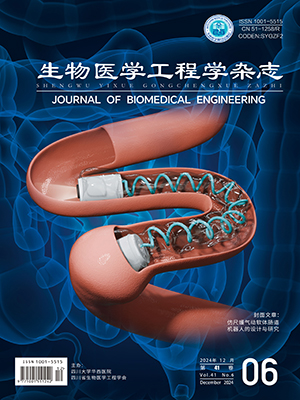| 1. |
Stenroos M, Koponen L M. Real-time computation of the TMS-induced electric field in a realistic head model. NeuroImage, 2019, 203: 116159.
|
| 2. |
Thielscher A, Antunes A, Saturnino G B. Field modeling for transcranial magnetic stimulation: a useful tool to understand the physiological effects of TMS// 2015 37th Annual International Conference of the IEEE Engineering in Medicine and Biology Society (EMBC). Milan: IEEE, 2015: 222-225.
|
| 3. |
Weise K, Numssen O, Thielscher A, et al. A novel approach to localize cortical TMS effects. Neuroimage, 2020, 209: 116486.
|
| 4. |
Windhoff M, Opitz A, Thielscher A. Electric field calculations in brain stimulation based on finite elements: an optimized processing pipeline for the generation and usage of accurate individual head models. Hum Brain Mapp, 2013, 34(4): 923-935.
|
| 5. |
Miranda P C, Hallett M, Basser P J. The electric field induced in the brain by magnetic stimulation: a 3-D finite-element analysis of the effect of tissue heterogeneity and anisotropy. IEEE Trans Biomed Eng, 2003, 50(9): 1074-1085.
|
| 6. |
Aberra A S, Wang B, Grill W M, et al. Simulation of transcranial magnetic stimulation in head model with morphologically-realistic cortical neurons. Brain Stimul, 2020, 13(1): 175-189.
|
| 7. |
Åström M, Lemaire J J, Wårdell K. Influence of heterogeneous and anisotropic tissue conductivity on electric field distribution in deep brain stimulation. Med Biol Eng Comput, 2012, 50(1): 23-32.
|
| 8. |
Codecasa L, Di Rienzo L, Weise K, et al. Fast MOR-based approach to uncertainty quantification in transcranial magnetic stimulation. IEEE Trans Magn, 2015, 52(3): 1-4.
|
| 9. |
Xu G, Rathi Y, Camprodon J A, et al. Rapid whole-brain electric field mapping in transcranial magnetic stimulation using deep learning. PLoS One, 2021, 16(7): e0254588.
|
| 10. |
Wagner T A, Zahn M, Grodzinsky A J, et al. Three-dimensional head model simulation of transcranial magnetic stimulation. IEEE Trans Biomed Eng, 2004, 51(9): 1586-1598.
|
| 11. |
Tuch D S, Wedeen V J, Dale A M, et al. Conductivity tensor mapping of the human brain using diffusion tensor MRI. Proc Natl Acad Sci, 2001, 98(20): 11697-11701.
|
| 12. |
Rullmann M, Anwander A, Dannhauer M, et al. EEG source analysis of epileptiform activity using a 1 mm anisotropic hexahedra finite element head model. NeuroImage, 2009, 44(2): 399-410.
|
| 13. |
McCann H, Pisano G, Beltrachini L. Variation in reported human head tissue electrical conductivity values. Brain Topogr, 2019, 32(5): 825-858.
|
| 14. |
Güllmar D, Haueisen J, Reichenbach J R. Influence of anisotropic electrical conductivity in white matter tissue on the EEG/MEG forward and inverse solution. A high-resolution whole head simulation study. NeuroImage, 2010, 51(1): 145-163.
|
| 15. |
Salinas F S, Lancaster J L, Fox P T. 3D modeling of the total electric field induced by transcranial magnetic stimulation using the boundary element method. Phys Med Biol, 2009, 54(12): 3631-3647.
|
| 16. |
Thielscher A, Opitz A, Windhoff M. Impact of the gyral geometry on the electric field induced by transcranial magnetic stimulation. NeuroImage, 2011, 54(1): 234-243.
|
| 17. |
Hjerrild J, Holboll J, Henriksen M, et al. Effect of semicon-dielectric interface on conductivity and electric field distribution. IEEE Trans Dielectr Electr Insul, 2002, 9(4): 596-603.
|
| 18. |
Weise K, Di Rienzo L, Brauer H, et al. Uncertainty analysis in transcranial magnetic stimulation using nonintrusive polynomial chaos expansion. IEEE Trans Magn, 2015, 51(7): 5000408.
|
| 19. |
Soldati M, Laakso I. Effect of electrical conductivity uncertainty in the assessment of the electric fields induced in the brain by exposure to uniform magnetic fields at 50 Hz. IEEE Access, 2020, 8: 222297-222309.
|
| 20. |
Saturnino G B, Thielscher A, Madsen K H, et al. A principled approach to conductivity uncertainty analysis in electric field calculations. NeuroImage, 2019, 188: 821-834.
|
| 21. |
Ciechanski P, Carlson H L, Yu S S, et al. Modeling transcranial direct-current stimulation-induced electric fields in children and adults. Front Hum Neurosci, 2018, 12: 268.
|
| 22. |
Miranda P C, Correia L, Salvador R, et al. Tissue heterogeneity as a mechanism for localized neural stimulation by applied electric fields. Phys Med Biol, 2007, 52(18): 5603.
|
| 23. |
Lucia M D, Parker G J, Embleton B K, et al. Diffusion tensor MRI-based estimation of the influence of brain tissue anisotropy on the effects of transcranial magnetic stimulation. NeuroImage, 2007, 36(4): 1159-1170.
|
| 24. |
Opitz A, Windhoff M, Heidemann R M, et al. How the brain tissue shapes the electric field induced by transcranial magnetic stimulation. NeuroImage, 2011, 58(3): 849-859.
|
| 25. |
Geeter N D, Crevecoeur G, Dupré L, et al. A DTI-based model for TMS using the independent impedance method with frequency-dependent tissue parameters. Phys Med Biol, 2012, 57(8): 2169.
|
| 26. |
Rashed E A, Gomez-Tames J, Hirata A. Deep learning-based development of personalized human head model with non-uniform conductivity for brain stimulation. IEEE Trans Med Imaging, 2020, 39(7): 2351-2362.
|
| 27. |
Silva S, Basser P J, Miranda P C. Elucidating the mechanisms and loci of neuronal excitation by transcranial magnetic stimulation using a finite element model of a cortical sulcus. Clin Neurophysiol, 2008, 119(10): 2405-2413.
|
| 28. |
Gomez-Tames J, Laakso I, Hirata A. Review on biophysical modelling and simulation studies for transcranial magnetic stimulation. Phys Med Biol, 2020, 65(24): 24TR03.
|
| 29. |
D'Alessandro S, Handler M, Saba R, et al. Computer simu1ation of the e1ectrica1 stimulation of the human vestibu1ar system: effects of the reactive component of impedance on vo1tage wavefonn and nerve se1ectivity. J Assoc Res Otolaryngol, 2022, 23(6): 815-833.
|
| 30. |
Kaden E, Kruggel F, Alexander D C. Quantitative mapping of the per-axon diffusion coefficients in brain white matter. Magn Reson Med, 2016, 75(4): 1752-1763.
|




